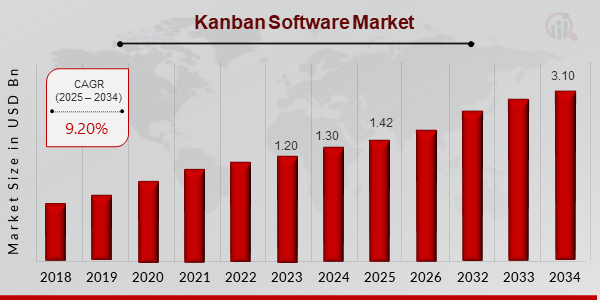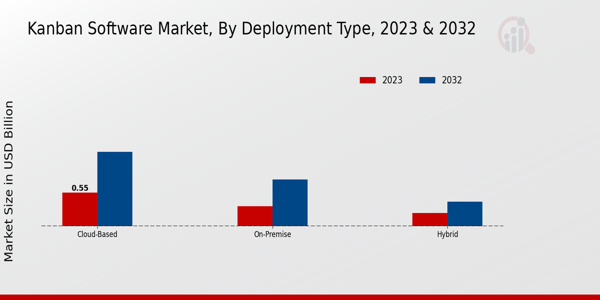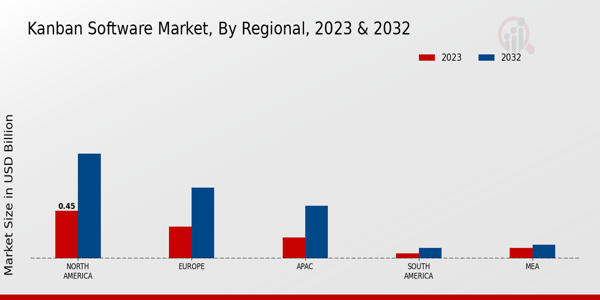Kanban Software Market Overview
Kanban Software Market is projected to grow from USD 1.42 Billion in 2025 to USD 3.10 Billion by 2034, exhibiting a compound annual growth rate (CAGR) of 9.20% during the forecast period (2025 - 2034).
Additionally, the market size for Kanban Software Market was valued at USD 1.30 billion in 2024.
Key Kanban Software Market Trends Highlighted
A number of significant market factors are causing the kanban software industry to change. The growing demand for businesses to increase productivity and efficiency in their processes is one of the primary motivators. Businesses are looking for adaptable solutions that improve project management transparency and teamwork. Kanban software is a desirable option since the increase in remote work has increased the need for digital tools that help teams better manage projects and visualize tasks. Additionally, because Kanban methods fit in well with an iterative and customer-centric approach, interest in them has grown as a result of the continuous push towards agile methodologies. The environment of Kanban software offers a wide range of opportunities. Businesses in a variety of sectors are realizing the advantages of implementing Kanban principles to optimize workflows. Software developers have opportunities to construct adaptable solutions that meet a range of user needs thanks to the possibility of integration with other tools and platforms.
The Kanban Software Market is evolving due to several key market drivers. One of the main drivers is the increasing need for organizations to improve efficiency and productivity in their workflows. Companies are seeking flexible solutions that enhance collaboration and transparency in project management.The rise of remote work has further fueled the demand for digital tools that enable teams to visualize tasks and manage projects more effectively, making Kanban software an attractive choice. Additionally, the ongoing push towards agile methodologies has increased interest in Kanban practices, as they align well with an iterative and customer-centric approach.
Opportunities in the Kanban software landscape are vast and varied. Organizations across different industries are recognizing the benefits of adopting Kanban principles to streamline processes. The potential for integration with other tools and platforms presents avenues for software developers to create versatile solutions that cater to various user needs.Moreover, there is a growing focus on enhancing user experience through improved interfaces and features, which can attract new customers and retain existing ones. Cloud-based solutions are becoming increasingly popular, allowing businesses to leverage scalability and accessibility while reducing infrastructure costs.
Trends in recent times indicate a shift towards increased customization and automation in Kanban software. Users are looking for tools that not only visualize tasks but also provide insights through analytics and reporting. The incorporation of artificial intelligence and machine learning is also gaining momentum, as these technologies can improve forecasting and decision-making.Integration with other project management systems and tools is becoming crucial as organizations seek seamless workflows. Overall, the continuous evolution of user demands and advancements in technology will shape the future of the Kanban software market.
Figure 1: Kanban Software Market size 2025-2034

Source: Primary Research, Secondary Research, MRFR Database and Analyst Review
Kanban Software Market Drivers
Growing Demand for Agile Project Management Tools
The Kanban Software Market IndustryMarket is experiencing an increasing demand for agile project management tools as organizations strive for operational efficiency and flexibility. Agile methodologies have proven to enhance productivity by allowing teams to adapt quickly to changing project requirements and market conditions.Kanban software specifically offers a visual representation of workflow, making it easier for teams to manage their tasks and allocate resources effectively. This visibility promotes better collaboration and transparency among team members, leading to improved project outcomes. With businesses increasingly recognizing the importance of agility in their processes, the Kanban software market is poised for substantial growth.
The rise of remote work and geographically distributed teams is also contributing to this trend as organizations seek tools that facilitate better workflow management across locations.As more companies aim to streamline their processes while maintaining high standards of quality, the adoption of Kanban software will likely continue to rise, further solidifying its position in the Kanban Software Market IndustryMarket.
Integration with Other Software Tools
The increasing integration of Kanban software with other productivity and project management tools is a significant driver of growth in the Kanban Software Market IndustryMarket. Organizations are looking for seamless solutions that combine various functionalities, allowing teams to manage everything from task assignments to progress tracking within a unified platform.
This capability not only enhances user experience but also accelerates decision-making processes, which is crucial for teams operating in fast-paced environments.Moreover, such integrations lead to better data synchronization and analytics, enabling organizations to make more informed strategic decisions.
Focus on Enhanced Team Collaboration
The emphasis on fostering enhanced team collaboration is driving the expansion of the Kanban Software Market IndustryMarket. As remote work and teams become more prevalent, organizations are investing in tools that facilitate communication and collaboration among team members.
Kanban software allows teams to visualize workflows, making it easier to share progress and updates in real-time. This capability is vital for keeping everyone aligned and informed, regardless of their physical location.As companies continue to prioritize a collaborative culture, the demand for Kanban software is likely to grow, contributing positively to the market's future outlook.
Kanban Software Market Segment Insights
Kanban Software Market Deployment Type Insights
The Kanban Software Market is witnessing a significant shift in deployment types, with notable growth across various models.As organizations increasingly demanded flexibility and scalability, the Cloud-Based deployment type emerged as the dominant choice, holding a market valuation of 0.55 billion USD this year, which is projected to grow to 1.22 billion USD by 2032. This deployment model was favored for its ease of access, cost-effectiveness, and ability to provide real-time collaboration among distributed teams.
On-premise solutions also gained traction, valued at 0.33 billion USD in 2023, with future estimates suggesting an increase to 0.77 billion USD by 2032. This segment appealed to businesses prioritizing data security and compliance, making it a significant player, albeit smaller than its cloud counterpart.
The Hybrid deployment type, while at a lower valuation of 0.22 billion USD, is anticipated to grow to 0.4 billion USD by the end of the forecast period. This model accommodated organizations seeking a blend of cloud benefits along with the security and control that come from on-premise installations.The growth trajectory of the Kanban Software Market demonstrated how companies are adapting to evolving work environments, with increasing reliance on technology for project management.
As stakeholders continue to recognize the value of Kanban methodologies in enhancing productivity and workflow transparency, the demand across these deployment types will likely evolve, reflecting broader trends in remote work and digital transformation. With the increasing complexity of projects, Kanban software serves as a pivotal tool, driving the need for specific deployment strategies that align with operational goals and security requirements.Thus, the market growth will continue to be propelled by these prevailing trends and the unique advantages each deployment type offers to organizations worldwide.
Figure 2 : Kanban Software Market 2023-2032

Source: Primary Research, Secondary Research, MRFR Database and Analyst Review
Kanban Software Market Application Insights
The market segmentation within this domain highlights the diverse applications of Kanban software, particularly in IT Project Management, Manufacturing, Product Development, Sales and Marketing, and Human Resources. Among these, IT Project Management has emerged as a critical area, facilitating enhanced workflow efficiency and transparency in processes. Manufacturing also plays a significant role in improving production efficiency and reducing bottlenecks.
The Product Development sector benefits from Kanban's visual management tools, enabling teams to prioritize tasks effectively. In Sales and Marketing, the software assists in tracking campaign progress, while in Human Resources, it optimizes recruitment workflow. The overall market growth is driven by the increasing need for operational efficiency and the ability to adapt to changing market demands.However, challenges such as the need for integration with existing systems and resistance to change can hinder adoption rates. The opportunities lie in expanding functionalities and integrating AI-driven insights to further enhance project management capabilities.The Kanban Software Market statistics illustrated a promising landscape as industries increasingly recognize the benefits of visual management systems for streamlined processes.
Kanban Software Market Organization Size Insights
The segmentation of the market into Small Enterprises, Medium Enterprises, and Large Enterprises reflects different adoption rates and operational needs. Small Enterprises often seek agile solutions for cost efficiency and streamlined project management, making them significant players in the Kanban Software realm.Medium Enterprises, benefiting from scalable processes, leverage Kanban to enhance productivity and inter-departmental collaboration, thereby holding a notable share of the market.
Meanwhile, Large Enterprises are increasingly adopting advanced Kanban solutions to manage complex projects and large teams efficiently. This shift is driven by the need for improved visibility and workflow optimization in diverse business environments.Overall, the Kanban Software Market revenue demonstrates that varying organization sizes play a crucial role in market growth, with each segment contributing uniquely to evolving trends and demands within the industry. As the market continues to expand, it is vital to observe shifts in adoption patterns and preferences across these organizational sizes.
Kanban Software Market End User Insights
Key sectors such as IT Telecommunications and Healthcare leverage Kanban methodologies to enhance workflow efficiencies and project management, making them significant contributors to this market. Retail environments benefit from streamlined processes and inventory management, while Education sectors adopt Kanban software to improve learning project supervision.Manufacturing stands out with its high reliance on Kanban principles, driving production optimization and lean practices.
These dynamics underscore the importance of the diverse End User applications, showcasing how the Kanban Software Market revenue will be shaped by specific industry needs and trends over the forecast period, emphasizing the robust demand reflected in the Kanban Software Market statistics and data.As organizations increasingly focus on agile methodologies and process improvements, opportunities continue to rise, further fueling the growth of this market.
Kanban Software Market Regional Insights
The market was segmented geographically, with North America leading the way as the dominant player, accounting for 0.45 USD Billion in 2023 and projected to grow to 0.99 USD Billion by 2032, representing a majority holding that underscores its critical position in the Kanban Software landscape.Europe followed with a significant share valued at 0.3 USD Billion in 2023, likely advancing to 0.67 USD Billion by 2032, indicating strong adoption driven by increasing demand for project management solutions.
The APAC region, valued at 0.2 USD Billion in 2023 with expectations to reach 0.5 USD Billion, also showed notable potential as businesses increasingly adopt agile methodologies. South America and MEA, though smaller, presented opportunities for growth, with valuations of 0.05 and 0.1 USD Billion in 2023, respectively, indicating a developing interest in Kanban methodologies in these regions.The Kanban Software Market statistics revealed regional disparities driven by technological advancements and varying market needs, contributing to a dynamic competitive landscape as organizations seek efficiency and streamlined workflows.
Figure 3 : Kanban Software Market 2023-2032

Source: Primary Research, Secondary Research, MRFR Database and Analyst Review
Kanban Software Market Key Players and Competitive Insights
The Kanban Software Market is experiencing significant growth due to the increasing demand for efficient project management solutions across various industries. As organizations strive for enhanced productivity and workflow optimization, Kanban software is becoming a critical tool for visualizing work processes, managing tasks, and promoting collaboration among team members.The competitiveness in this market is characterized by the presence of multiple players offering diverse solutions, with technological advancements steering the features and functionalities of these software applications. Companies are continuously innovating and adapting their offerings to meet the evolving needs of users, fostering a dynamic environment where well-established brands compete alongside emerging startups.
Kanbanize has established a strong foothold within the Kanban Software Market, leveraging its comprehensive approach to visual project management. The software offers robust features that cater to the needs of teams of all sizes, emphasizing the importance of real-time updates and seamless collaboration.Its unique selling points include advanced analytics that provides insights into project performance and bottlenecks, enabling teams to fine-tune their workflows effectively. Furthermore, Kanbanize's user-friendly interface ensures ease of use, allowing organizations to adopt it rapidly without extensive training.
The platform's scalability is another significant advantage, as it can accommodate the growing demands of teams and projects, solidifying its position as a preferred choice for many businesses looking to enhance their operational efficiency.Miro, as a prominent player in the Kanban Software Market, is recognized for its versatile online collaborative whiteboard platform that integrates Kanban functionalities. Miro's strength lies in its ability to facilitate interactive and visually engaging experiences for teams, promoting creativity and brainstorming in addition to task management.
The software boasts an extensive library of templates, including those tailored specifically for Kanban workflows, allowing users to customize their boards to fit their project requirements. Miro's emphasis on integration capabilities further enhances its appeal, as it can seamlessly connect with various project management tools and applications, ensuring a cohesive workflow across different systems.This flexibility and focus on user experience have positioned Miro as a valuable tool for organizations seeking to manage projects efficiently while fostering team collaboration.
Key Companies in the Kanban Software Market Include
-
Kanbanize
-
Miro
-
Smartsheet
-
VersionOne
-
ClickUp
-
Asana
-
Atlassian
-
Monday.com
-
Targetprocess
-
TeamGantt
-
Aha!
-
Jira
-
Wrike
-
Trello
-
LeanKit
Kanban Software Market IndustryMarket Developments
Recent developments in the Kanban Software Market have shown dynamic growth amid increasing demand for productivity tools. Companies like Kanbanize and Miro are expanding their features to cater to remote teams, reflecting a growing trend in work-from-home environments.Smartsheet and VersionOne have also introduced integrations with popular platforms to enhance usability. Companies such as ClickUp, Asana, and Atlassian continuously innovate by adding collaborative functionalities to attract a wider user base.
There have been noteworthy merger and acquisition activities, significant within the landscape; notably, Monday.com has been involved in strategic acquisitions to enhance its capabilities.Targetprocess has made strides in aligning its offerings with enterprise needs, while TeamGantt's growth reflects a rising preference for simpler project management solutions. The market valuation of companies like Jira and Wrike is surging as businesses prioritize efficiency and transparency.This surge in investments and expansion initiatives is reshaping the competitive landscape, indicating a robust future for Kanban solutions. Companies are focusing on integrating AI-driven analytics and enhancing user experiences to capture a larger share of this evolving market.
Kanban Software Market Segmentation Insights
-
Kanban Software Market Deployment Type Outlook
-
Cloud-Based
-
On-Premise
-
Hybrid
-
Kanban Software Market Application Outlook
-
IT Project Management
-
Manufacturing
-
Product Development
-
Sales and Marketing
-
Human Resources
-
Kanban Software Market Organization Size Outlook
-
Small Enterprises
-
Medium Enterprises
-
Large Enterprises
-
Kanban Software Market End User Outlook
-
IT Telecommunications
-
Healthcare
-
Retail
-
Education
-
Manufacturing
-
Kanban Software Market Regional Outlook
-
North America
-
Europe
-
South America
-
Asia Pacific
-
Middle East and Africa
Kanban Software Market Report Scope
|
Report Attribute/Metric
|
Details
|
|
Market Size 2024
|
1.30 (USD Billion)
|
|
Market Size 2025
|
1.42 (USD Billion)
|
|
Market Size 2034
|
3.10 (USD Billion)
|
|
Compound Annual Growth Rate (CAGR)
|
9.20% (2025 - 2034)
|
|
Report Coverage
|
Revenue Forecast, Competitive Landscape, Growth Factors, and Trends
|
|
Base Year
|
2024
|
|
Market Forecast Period
|
2025 - 2034
|
|
Historical Data
|
2019 - 2023
|
|
Market Forecast Units
|
USD Billion
|
| Key Companies Profiled |
Kanbanize, Miro, Smartsheet, VersionOne, ClickUp, Asana, Atlassian, Monday.com, Targetprocess, TeamGantt, Aha!, Jira, Wrike, Trello, LeanKit |
| Segments Covered |
Deployment Type, Application, Organization Size, End User, Regional |
| Key Market Opportunities |
Increased remote work adoption, Integration with AI tools, Growing demand for agile methodologies, Expansion in SME usage, Enhanced data analytics capabilities |
| Key Market Dynamics |
Growing demand for agile methodologies, Increasing emphasis on process optimization, Rise in remote work collaboration tools, Integration with other project management software, Need for real-time visibility and tracking |
| Countries Covered |
North America, Europe, APAC, South America, MEA |
Frequently Asked Questions (FAQ) :
The Kanban Software Market is expected to be valued at
3.10 USD billion by 2034.
The expected CAGR for the Kanban Software Market from 2024 to 2034 is 9.0%.
North America is projected to have the largest market share, valued at 0.99 USD billion by 2032.
The market value of Cloud-Based Kanban Software is expected to reach 1.22 USD billion by 2032.
Key players in the Kanban Software Market include Kanbanize, Miro, Smartsheet, VersionOne, and ClickUp.
The expected market size for On-Premise Kanban Software is anticipated to be 0.77 USD billion by 2032.
The Kanban Software Market was valued at 1.1 USD billion in 2023.
Challenges influencing the market growth include data security concerns and competition among existing players.
The market value of Hybrid Kanban Software is expected to reach 0.4 USD billion by 2032.
The APAC region is anticipated to show significant growth, with a market value of 0.5 USD billion by 2032.

















